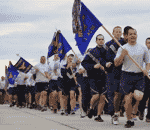Thought I’d keep it light this month. It’s possible someone told me I’d been a little preachy lately… but what do they know?
How do you know you’re leading? What do you measure? What do you look for?
Consulting the great Google oracle, it looks like 73,300,000 people already know and have written about it. (Heaven forbid the Google breaks; how will I ever conduct my research?)
Since I didn’t see what I was looking for, I thought I’d share a couple of lessons I learned about a decade ago, shortly after I’d taken command of a few hundred motivated and talented Airmen and was voluntold at the last minute that I would be leading the entire wing on its monthly run.
Disclaimer: I hate running.

Or so I thought.
Disclaimer #2: Because I was in training to go to the Army’s airborne training school the following month, I was quite possibly in the best shape of my life.

See, I never looked back, so I didn’t notice I’d left much of the wing behind. My boss, the wing commander, certainly noticed and was none too happy. Turns out the driver of the car kept speeding up so I didn’t get too close to him, and the real purpose of run was to build camaraderie and finish the “motivational” run together… not to demonstrate individual athletic prowess. If only I’d known.
So here are some lessons I learned:
- Leaders have to know where they’re going, and they have to know how they’re going to lead people there. I didn’t have a vision or a goal or a clue, and while the pace car followed the correct route, I clearly didn’t understand where we were going, why we were going there, or how we were going to get there together (which we didn’t).As a leader, the only reason people will follow you if they don’t think you don’t know where you’re going is if they have to (as in this case) or out of sheer curiosity. A wise old mentor used to tell me, “if you don’t know where you’re going, a step in any direction looks like progress.” Which brings me to my second lesson.
- All leaders – good, bad and ugly – have one thing in common: they have followers. If just once during the run I’d looked behind me, I would have discovered my error. The people behind me actually knew the way to success, but I inadvertently turned it into a miserable experience for them because I didn’t check on them from time to time.Three reasons people don’t do what’s expected: they don’t know how, they don’t want to, or we won’t let them. In this case, I didn’t let them.

- Leaders give people permission to throw the bull shit flag. I was new. I had some proud, really physically fit Airmen right behind me (and the poor guy carrying the guidon). They didn’t know me well enough – so they didn’t trust me enough – to say, “Hey, slow down… we’re leaving everyone else behind!” Just one voice of dissention would have pulled me up short, but they weren’t sure how I’d react.

I’m sure I’m the only one who learned anything from that miserable 11 ½ minutes (did I mention I hate to run?), but I was thankful to learn those lessons early in the two-year assignment. But in retrospect, I was not nearly as thankful as those light, lean, and lethal Airmen I commanded for two years who dared mighty things and showed courage in adversity (it’s code; they’ll know who I’m talking about).
So, create your own score card. Do you know where you’re going? Is anyone following you? Do you care more about others than yourself? Are people afraid to give you feedback?
Answering those questions back then helped me to realize I was not leading the way I wanted to, and it changed the future for a whole lot of people, myself included.
How about you… how do you know if you’re leading?
I’d love for you to share your measures of success.

